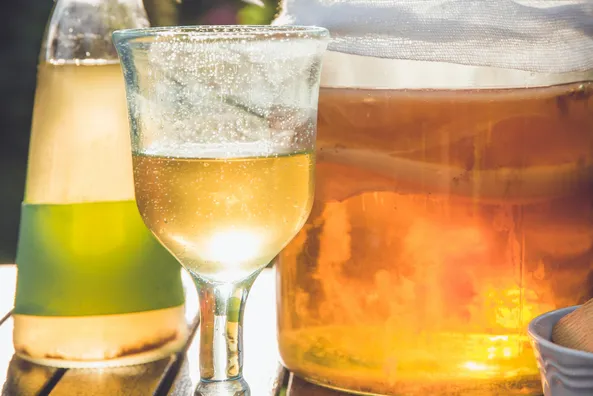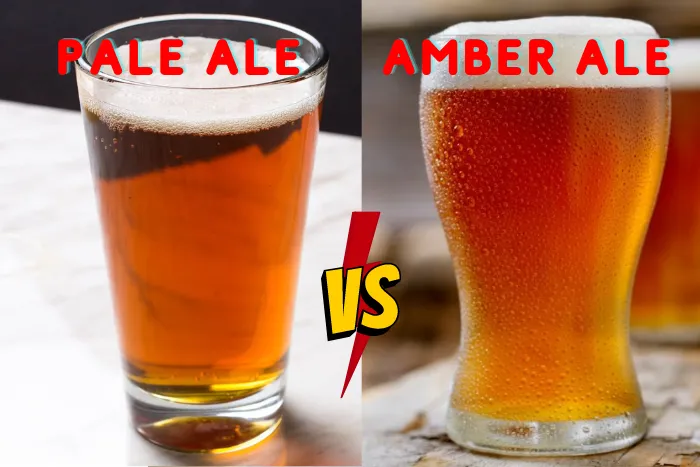Amber and pale ale may seem similar, but many distinctions set them apart. From their origins to brewing processes, flavor profiles, color, and alcohol content, a lot sets amber ales apart from pale ales. In this blog post, we’ll explore all these differences between amber ale vs. pale ale so you can make an informed decision when choosing your next craft beer. We’ll also provide some recommendations for popular beers in each style and discuss the pros and cons of both types. So let’s dive into our exploration of amber versus pale.
Table of Contents:
- Origins and History of Amber Ale and Pale Ale
- Ingredients, Fermentation, and Brewing Processes for Amber Ale and Pale Ale
- Flavor Profile, Color, Alcohol Content, IBU, and Health Impact of Amber Ale vs Pale Ale Beers
- FAQs in Relation to Amber Ale vs Pale Ale
- Conclusion
Origins and History of Amber Ale and Pale Ale

Origin of Amber Ale
Amber ale was first developed in the UK during the late 19th century. Its namesake is derived from its orange-brown hue. It is made with pale malt and caramelized malts, which gives it its distinctive amber color. The name “amber” comes from the fact that this beer style has an orange-brown hue.
Amber ale was devised as a way to reproduce classic English brews without the use of pricey dark roasted malts. Amber ales are generally low in bitterness and have moderate alcohol content (4%-6% ABV).
Origin of Pale Ale
Pale ale, a style of beer originating in England during the 18th century, is characterized by its use of lightly kilned barley or wheat malt instead of darker roasted malts. Unlike amber ales, pale ales are brewed with lightly kilned barley or wheat malt instead of darker roasted malts like chocolate or black patent malt. It produces a much lighter colored brew than other styles, such as stouts and porters.
Pale ales typically have higher levels of hop bitterness than their amber counterparts (30-50 IBU) and can range anywhere from 4%-7% ABV depending on the brewed variety.
Historical Development Of Amber Ale And Pale Ale
Amber ale and pale ale have undergone many changes since their origins centuries ago. In terms of ingredients, modern versions often contain more specialty grains such as crystal or Vienna malt for added flavor complexity compared to their historical predecessors, who relied mainly on pale base malts for fermentation purposes only.
Additionally, Breeding techniques have made hop varieties more aromatic. Regarding brewing processes, some brewers choose to dry hop their beers post fermentation while others opt for cold conditioning methods instead.
These variations result in different flavor profiles, colors, alcohol contents, IBUs, and health impacts between both styles when comparing them.
Ingredients, Fermentation, and Brewing Processes for Amber Ale and Pale Ale
Amber ales and pale ales are two of the most popular beer styles in the world. Brewing methods, components, and fermentation may contrast significantly when crafting either type of beer.
Ingredients Used in Amber Ales
Amber ales combine malted barley, hops, yeast, and water as their main ingredients. They also often contain specialty grains such as caramel or crystal malt for added flavor and color.
Cascade or Willamette balls give amber ales floral and citrus aromas. This style uses clean American ale yeasts and more complex Belgian-style yeasts that add fruity esters.
Ingredients Used in Pale Ales
In contrast to amber ales, pale ales are brewed with a much lighter base malt, such as pilsner or Vienna malt, that gives them an appearance of golden hue rather than the more common amber color.
Centennial and Citra hops, added late into the boil during dry hopping after primary fermentation, impart tropical fruit and citrus zest flavours. Pale ale yeast strains are neutral American Ale strains that let hop character shine without wild yeast flavors like Belgian-style beers.
Brewers control fermentation by maintaining specific temperatures, knowing how temperature affects flavor and carbonation in either beer type. Subtle variations are present between both beers due to their ingredients being converted into alcohol through the chosen yeast strain. Experienced brewers should capitalize on these differences when making their final product.
Flavor Profile, Color, Alcohol Content, IBU, and Health Impact of Amber Ale vs Pale Ale Beers

There are significant differences in flavor, hue, ABV (Alcohol By Volume), IBU (International Bitterness Unit), and health effects between the two ales.
Taste Comparison of Amber and Pale Ale
Amber ales tend to be sweeter than pale ales, owing to their utilization of darker malts which deliver a caramel-like flavor.
Pale ale, on the other hand, is usually more bitter as it uses lighter malts with a higher concentration of hops, giving off an earthy or citrus-like taste.
Color Difference of Amber and Pale Ale
The color difference between these two beers is also quite distinct; amber ale has an orange-brown hue, while pale ale typically has a light golden-yellow tint.
It can vary depending on how much malt was used during brewing, but generally speaking, you can tell one from another by looking at its color alone.
Alcohol Content in Amber and Pale Ale
Amber Ale typically has an ABV (alcohol by volume) of 4-6%, while Pale Ale generally has a higher range of 5-7%. Moderation is advised when drinking either style due to the higher percentage.
International Bitterness Unit (IBU) of Amber Ales and Pale
The International Bitterness Unit (IBU) of Amber Ales and Pale Ales varies drastically; typically, IBUs for an Amber Ale range from 15-25, while a Pale Ale’s IBUs usually hit between 30-45, making the latter notably more bitter than its counterpart. Consequently, imbibers should be mindful when consuming either style to avoid intoxication at too rapid a rate.
Health Impact of Amber and Pale Ale
Finally, when it comes to health impacts associated with either style, there is little difference; moderate consumption won’t harm regardless of whether you’re drinking Amber Ale or Pale Ale. Darker beers like Amber Ale may reduce inflammation if consumed regularly in small amounts.
FAQs in Relation to Amber Ale vs Pale Ale
Can a pale ale be amber?
Yes, a pale ale can be amber. Beer can be light to amber, depending on the malt and boiling time. Pale ales typically use light-colored malts that produce a lighter hue when brewed. Adding more caramel or crystal malts during brewing produces an amber beer.
What are the qualities of amber ale?
Amber ale is a type of beer with a medium-bodied, malty sweetness and an amber to copper color. It has caramel, toast, biscuit, nutty, and roasted malt flavors with a hint of hop bitterness.
Amber ales may vary in taste, ranging from sweet and malty to bitter and hoppy. They usually have a moderate alcohol content between 4%-6% ABV. Amber ales are excellent for beginners and experienced craft beer drinkers because of their flavor balance.
What is the difference between pale ale and brown ale?
Pale and brown ales are both brews, but they differ in hue, taste characteristics, and ingredients. Pale ales tend to be light-colored with a hoppy aroma and taste often described as citrusy or floral.
They are made with pale malt barley for the base grain, giving them a lighter hue. Brown ales are sweeter than pale ales because chocolate or crystal malt adds caramel, coffee, nuts, toastiness, and more. Brown ales have fewer bitter hops than pale ales, making them more balanced.
What are the 3 major classifications of beer?
There are three significant types of beer: ales, lagers, and hybrids. Ales are top-fermented beers that taste more complex because they are fermented at higher temperatures.
Lagers are beers that are fermented from the bottom up. Because they are fermented at a lower temperature, they taste cleaner. Hybrids take parts of ale and lager brewing to make flavors that can’t be found alone. All three types offer different tastes and experiences for craft beer enthusiasts.
Conclusion
In conclusion, amber ale and pale ale beers are two distinct beer styles with unique origins, ingredients, fermentation processes, and flavor profiles. It is essential to comprehend the distinctions between amber and pale ale before deciding which beer you will choose for your enjoyment.
Amber ales tend to be maltier with a higher alcohol content than their lighter-colored counterparts, offering plenty of bitterness from hops. Pale ales, on the other hand, can range in color but generally contain fewer malts resulting in lower alcohol levels and more floral aromas and citrusy hop notes.
Whether you prefer an amber or pale ale depends mainly on personal preference; however, understanding what makes each style different will help you decide when selecting which type of beer best suits your tastes.
Also See: Indian Pale Lager vs Indian Pale Ale : What’s the Difference?

